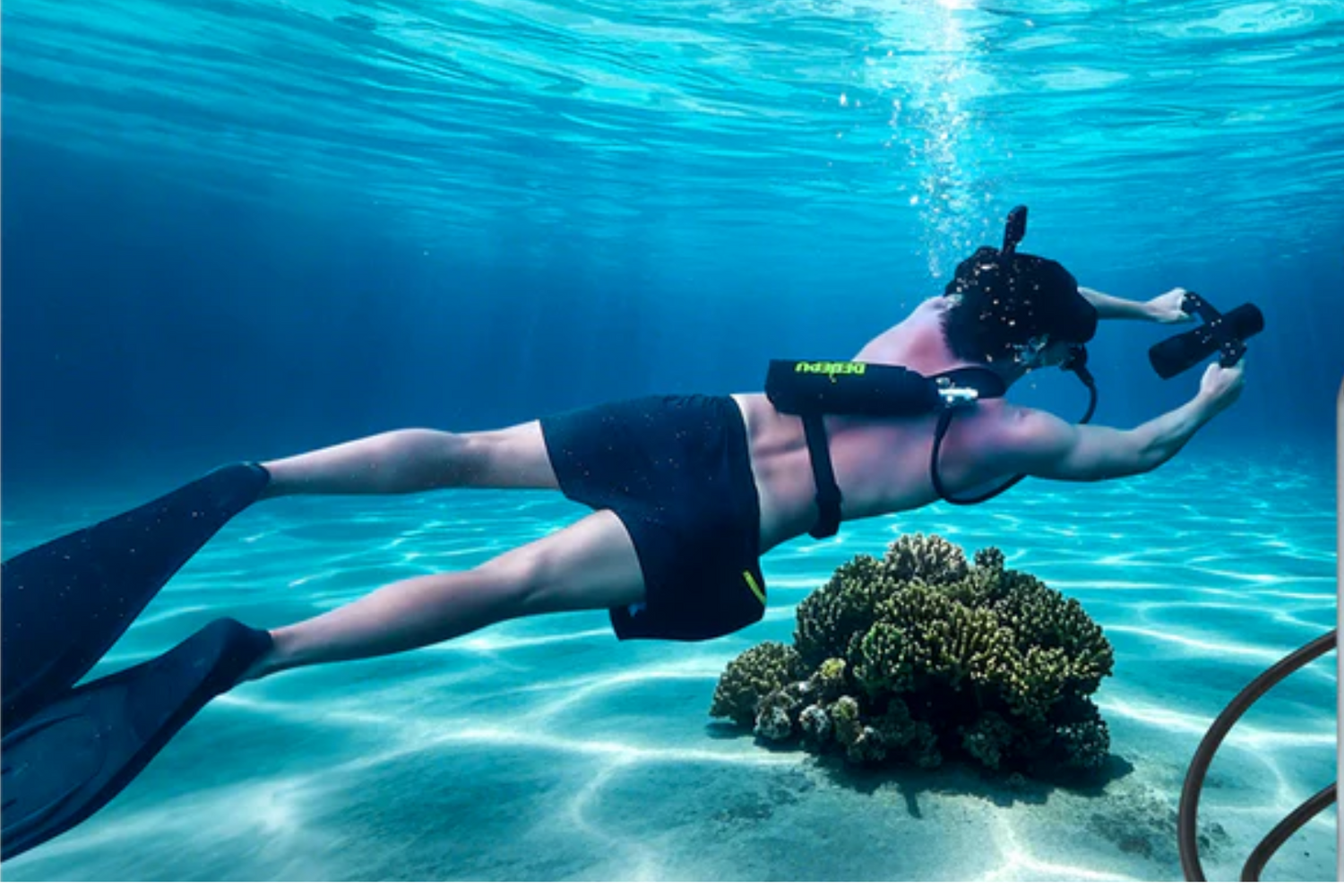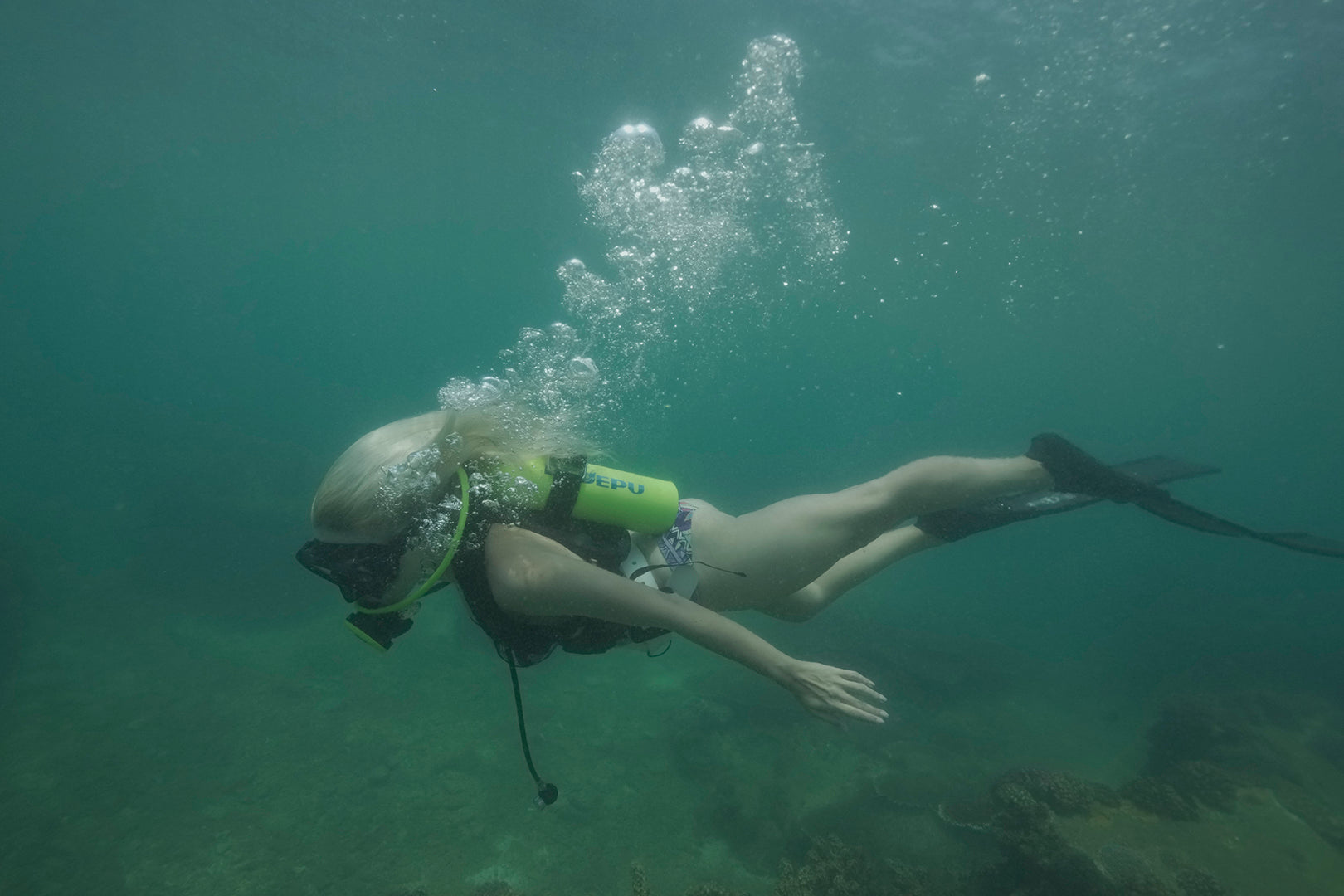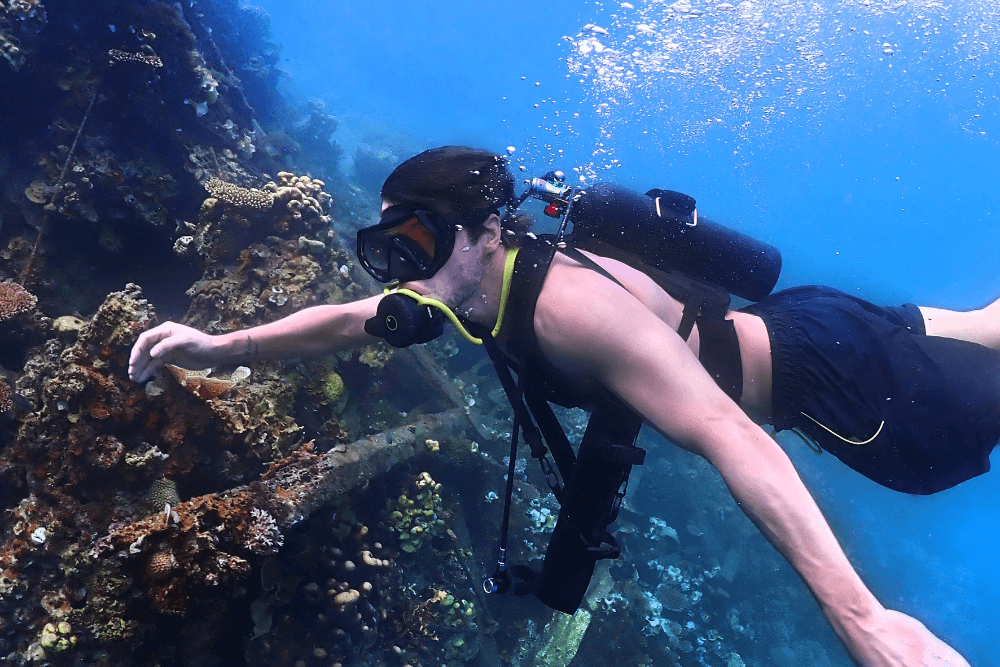Remplir une bouteille de plongée sous-marine à la pression correcte est crucial pour votre sécurité et vos performances de plongée. La pression à laquelle on remplit une bouteille de plongée sous-marine affecte directement l'approvisionnement en air et la durée de la plongée.
Ce guide explique comment remplir votre bouteille de plongée. Il aborde les types de bouteilles, les facteurs qui influencent la pression et les risques liés à une mauvaise pression.
Pression standard du réservoir de plongée sous-marine
Pour la plupart des bouteilles de plongée récréative, la pression standard est de 3 000 psi, ce qui est idéal pour une bouteille d'aluminium typique de 80 pieds cubes.
Si vous avez besoin d'une option plus compacte et portable, unMini réservoir de plongée propose une solution plus compacte et légère avec des pressions allant jusqu'à 3000 psi et des capacités comprises entre 0,5L et 2,3L. Découvrez une variété d'options pour les mini bouteilles de plongée surdedepudive.com.
Lecture connexe : Pourquoi les plongeurs transportent des mini-bouteilles de plongée
Plages de pression pour différents types de réservoirs
Les bouteilles de plongée sous-marine existent en différents types, chacun ayant des capacités de pression variables. Voici un aperçu rapide :
Réservoirs haute pression
Les bouteilles à haute pression, souvent utilisées en plongée technique, peuvent supporter des pressions allant de 3 300 à 3 500 psi. Ces bouteilles permettent aux plongeurs de transporter plus d'air, ce qui les rend adaptées pour des plongées plus profondes ou des temps de fond plus longs.
Taille du réservoir et pression idéale
Pour la plupart des bouteilles en aluminium, la pression est généralement réglée à 3 000 psi. Cependant, pour les bouteilles plus grandes, comme celles de 100 ou 120 pieds cubes, les techniciens règlent généralement la pression autour de 3 200 à 3 300 psi. Vérifiez toujours les spécifications de la bouteille avant de la remplir pour garantir la pression correcte.

Facteurs influençant la pression des bouteilles de plongée sous-marine
Impact du matériau du réservoir
Le matériau de votre bouteille de plongée sous-marine joue un rôle clé dans sa pression nominale.
- Les fabricants classent généralement les bouteilles en aluminium pour une pression de 3 000 psi, ce qui est idéal pour la plupart des plongeurs récréatifs.
- Les réservoirs en acier sont robustes. Ils peuvent supporter des pressions allant jusqu'à 4 500 psi. Cela en fait un bon choix pour les plongées techniques ou pour un approvisionnement en air plus prolongé.
Effet de la température sur la pression
La température peut affecter significativement la pression des bouteilles de plongée. Lorsque la température augmente, l'air à l'intérieur de la bouteille se dilate, ce qui élève la pression interne. Les bouteilles remplies dans des environnements chauds peuvent devenir surpressurisées si la température baisse ultérieurement. Remplissez toujours les bouteilles à des températures modérées pour éviter ce risque.
Réglages d'altitude et de pression
Lors du remplissage des bouteilles de plongée en altitude, la pression de l'air ambiant est plus faible. Cela signifie que les bouteilles remplies au niveau de la mer pourraient ne pas atteindre la même pression interne à des altitudes plus élevées. Ajustez les procédures de remplissage en fonction de l'altitude pour éviter de dépasser les limites de pression de la bouteille.
Spécifications du fabricant : La Pression Maximale de Travail (PMT)
Avant de remplir votre réservoir, vérifiez toujours la pression maximale de service (PMS) indiquée par le fabricant. Cette conception permet à votre réservoir de supporter la pression maximale en toute sécurité. Vous pouvez trouver les marquages de la PMS directement sur le réservoir. Ne dépassez jamais cette pression pour éviter tout dommage.
Comment remplir en toute sécurité une bouteille de plongée à la bonne pression
Équipement essentiel pour un remplissage sous pression précis
Pour remplir en toute sécurité un réservoir de plongée, utilisez le bon équipement.
- Un compresseur de plongée conçu pour les bouteilles garantit un remplissage de pression précis.
- Un manomètre de haute qualité permet de surveiller la pression pendant le processus de remplissage et d'éviter un surremplissage.
Consignes de sécurité lors du remplissage des bouteilles de plongée sous-marine
Suivez ces consignes de sécurité pour éviter les accidents :
Portez des lunettes de sécurité et des gants de protection pour vous protéger contre les fuites potentielles ou les surpressions.
Toujours remplir les réservoirs dans un endroit bien ventilé pour éviter l'accumulation de gaz nocifs.
Ne laissez jamais un réservoir sans surveillance pendant le processus de remplissage.
Vérification de la Pression : Avant et Après le Remplissage
Avant de remplir, vérifiez la pression actuelle du réservoir à l'aide d'un manomètre pour voir s'il a besoin d'être rechargé. Après le remplissage, vérifiez à nouveau que le réservoir a atteint la pression correcte, sans dépasser la PMS. Si vous surchargez le réservoir, libérez un peu d'air pour ajuster la pression.
Risques de surremplissage d'une bouteille de plongée sous-marine
Dangers de surremplissage
Le surremplissage d'une bouteille de plongée sous-marine peut provoquer la rupture du disque de rupture, ce qui libère l'air rapidement et génère un bruit intense. Cette perte soudaine d'air peut être dangereuse et alarmante. Un surremplissage répété peut entraîner une fatigue du métal, affaiblissant la bouteille et augmentant le risque de rupture au fil du temps.
Comment éviter le surremplissage
Pour éviter le surremplissage :
- Surveillez toujours la pression du réservoir avec un manomètre fiable pendant le processus de remplissage.
- Respectez les limites de pression du fabricant et utilisez des équipements régulés conçus pour éviter une accumulation excessive de pression.
- Assurez-vous de remplir conformément aux normes de sécurité de l'industrie.

Les dangers d'une basse pression dans les bouteilles de plongée sous-marine
Temps de plongée réduit
Une faible pression signifie moins d'air à respirer, ce qui réduit la durée de votre plongée. Un air insuffisant entraîne des plongées plus courtes, limitant les activités comme l'exploration ou la photographie sous-marine.
Stress et panique sous l'eau
Manquer d'air pendant une plongée peut déclencher la panique, rendant plus difficile une réflexion claire et des décisions sûres. La peur de manquer d'air peut entraîner des mouvements irréguliers, augmentant le risque d'accidents.
Mauvaise Réponse d'Urgence
En cas d'urgence, comme aider un autre plongeur, des niveaux d'air faibles peuvent empêcher une action efficace. Sans assez d'air, vous ne pourrez peut-être pas agir rapidement, mettant en danger à la fois vous-même et les autres.
Comment éviter les dangers liés à la basse pression
Vérifiez toujours la pression de votre réservoir avant de plonger pour vous assurer qu'il est suffisamment rempli. Surveillez votre consommation d'air pendant la plongée et remontez lorsque vous atteignez votre réserve de sécurité. Plongez avec un binôme pour partager l'air si nécessaire, et respectez toujours les techniques de remontée sécurisées pour éviter les accidents de décompression.
Types de bouteilles de plongée sous-marine et leurs exigences de pression
Différences de Pression Entre les Réservoirs en Aluminium et en Acier
Le matériau du réservoir affecte sa pression nominale.
- Les réservoirs en aluminium sont plus légers mais ont une capacité de pression plus faible, généralement de 2400 à 2640 psi.
Réservoirs haute pression
- Notre réservoir à gaz est conçu pour résister à une pression maximale de 4500 psi, ce qui en fait un choix adapté à la plongée de loisir et de détente, offrant à la fois fiabilité et sécurité pour vos aventures sous-marines.
Réservoirs composites : une alternative légère
Les réservoirs composites, fabriqués en fibre de carbone ou en matériaux similaires, offrent un meilleur rapport résistance/poids. Vous pouvez les remplir à des pressions plus élevées sans ajouter de poids supplémentaire, ce qui permet une plus grande capacité en air. Cependant, ils nécessitent des procédures de remplissage spécifiques pour des raisons de sécurité.

Comment la pression affecte les performances de plongée
Pression et Temps de Plongée : Le Lien à Connaître
À mesure que vous descendez, la pression de l'eau augmente, ce qui provoque la compression de l'air dans votre réservoir et vos poumons. Cela entraîne une consommation d'air plus rapide, limitant ainsi votre temps de plongée. Les plongeurs doivent ajuster leur rythme respiratoire pour gérer l'air de manière plus efficace.
Adapter la pression du réservoir en fonction des différentes plongées
- Les réservoirs haute pression sont plus adaptés pour les plongées profondes ou prolongées, car ils stockent plus d'air dans un format plus compact.
- Les réservoirs basse pression conviennent aux plongées peu profondes et de courte durée, offrant une consommation d'air plus stable mais nécessitant des recharges plus fréquentes.
Planification de Plongée : Comment la Pression du Ballon Influence la Consommation d'Air
Une planification de plongée appropriée est cruciale. À mesure que la profondeur augmente, la pression monte, affectant la consommation d'air et l'absorption d'azote. Les plongeurs doivent calculer leur temps de plongée et la capacité de leur réservoir en fonction de la profondeur pour s'assurer d'avoir suffisamment d'air pour la remontée.
Comment remplir correctement votre bouteille de plongée sous-marine
Utilisation d'un compresseur pour le remplissage de réservoirs
Pour remplir votre bouteille de plongée en toute sécurité, suivez ces étapes :
- Assurez-vous que le compresseur est conçu pour les bouteilles de plongée sous-marine et est en bon état.
- Attachez le tuyau de remplissage à la valve du réservoir.
- Pressurisez lentement le réservoir jusqu'à la valeur de PSI souhaitée tout en surveillant attentivement le manomètre pour éviter un surgonflage.
Vérifications Clés Avant, Pendant et Après le Remplissage
- Avant : Vérifiez la pression du réservoir et inspectez tout dommage visible.
- Pendant : Surveillez la vitesse de remplissage et la pression à l'aide d'un manomètre fiable.
- Après : Vérifiez que la pression du réservoir correspond à la PMS, afin de garantir son utilisation en toute sécurité.
Reconnaître les marques de niveau de pression
La plupart des bouteilles de plongée ont des marquages visibles du niveau de pression sur l'épaule ou le col. Ces marquages indiquent la pression maximale de travail (PMW) de la bouteille, vous aidant à la remplir dans des limites sûres.
Maintenir la pression des bouteilles de plongée pour la sécurité et la longévité
Inspections régulières
Inspectez votre bouteille de plongée au moins une fois par an. Un technicien qualifié vérifiera les signes d'usure, de corrosion ou de dommages qui pourraient affecter la tolérance à la pression de la bouteille.
Prévention des fuites et de la perte de pression
Stockez votre réservoir dans un endroit frais et sec et assurez-vous que la valve est bien fermée lorsque vous ne l'utilisez pas. Vérifiez régulièrement la valve et les joints toriques pour détecter toute usure et remplacez-les si nécessaire.
Prolonger la durée de vie de votre réservoir
Entretenez votre bouteille de plongée en laissant une petite quantité d'air à l'intérieur pour éviter l'accumulation d'humidité. Suivez les recommandations du fabricant pour les tests hydrostatiques et rincez la bouteille après chaque plongée pour éliminer le sel ou les débris.
Conclusion
Remplir et maintenir correctement la pression de votre bouteille de plongée est essentiel à la fois pour la sécurité et les performances. Pour garder vos plongées sûres et prolonger la durée de vie de votre équipement, connaissez les niveaux de pression appropriés pour chaque bouteille.
Prenez en compte des facteurs comme la température et l'altitude. Suivez également de bonnes pratiques d'entretien.
Vérifiez toujours la pression avant de remplir. Planifiez correctement votre plongée pour éviter les risques. Cela aide à prévenir un remplissage excessif ou une perte d'air sous l'eau.




Laisser un commentaire
Tous les commentaires sont modérés avant d'être publiés.
Ce site est protégé par hCaptcha, et la Politique de confidentialité et les Conditions de service de hCaptcha s’appliquent.